Soil Health Management Plan - Process and Pilot
| Priming the SHMP process Group readiness | Farmer engagement GIS and property documentation Office GIS Session I (with farmers) | Office GIS Session II | Office AgriGater training session Paddock walks Evaluation and future work Evaluation | Future work | 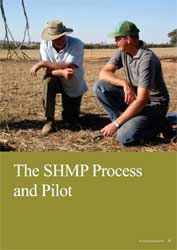 |
A balanced program of activities including education, engagement and experience provides the focus for different aspects of the soil health management plan. The starting point and expectations will vary between individuals —some one to one or small group discussion is essential.
Group readiness
A baseline level of knowledge and interest in natural resource management on the farm is desirable. This is something that can be engendered over time with groups at field days (e.g. soil pit days), seminars and training sessions. The MLSC had already built a strong interest in soil through other funded projects that focussed on 'biological farming' and on compost trials. Seventeen soil pits had been excavated, sampled and described for the group as part of the DPI support to these projects and to their 2008-09 'Caring for our Country' project11. Additionally, trial sites managed by the group had been surveyed by the former DPI using farm quad bike mounted remote sensing equipment12. These surveys highlighted soil variability at the trial sites, in particular demonstrating differences in subsoil quality. Several field days and presentations to the MLSC group occurred in the two years prior to the SHMP pilot. Two farms were selected for participation in the pilot. These will be referred to as HH and DC.
Farmer engagement
A clear enduring commitment by participants in the SHMP is needed. This cannot be achieved in an afternoon. The SHMP process involves documentation of existing and historic conditions, discovery of new knowledge, adoption of new tools, changes in perspective and consequent changes in practice.
The initial meeting was held in the kitchen at the HH farm. The MLSC group facilitator, owner of the HH farm and his nephew, and father and son from the DC farm attended the meeting. The whole morning was set aside for this. An introduction to the SHMP pilot was given, emphasising that:
- the SHMP should be their plan - it was only going to be facilitated, and not created, by a third party,
- commitment to the whole the process was a requisite and that time and 'homework' would be required,
- the SHMP does not need to be complex, but should be a level that can and will be acted on, and
- it should be central to the farm business, and some new business habits may be needed particularly for record
- keeping.
A series of prepared questions was used to lead the conversation (Appendix A - Questions):
Copies of the questions were given to the participants and interviews for the two farms were conducted. This process led to much open discussion about comparisons and differences of experience at the two farms. Emphasis was on the farmers and letting the conversation run. It's their business and it has to be their plan, so it was important not to dominate or lead too much at the inception of the project. The interviews and conversations throughout the morning were audio recorded with the permission of the participants. The farmers were also asked to complete written answers to the questions in their own time as homework and to return them to the SHMP project manager at the former DPI. | 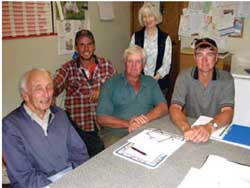 Figure 10. Kitchen table discussion kicking off the soil health management plan process - two farms and two generations. |
Landholders were engaged in an interactive GIS session to identify their properties and to view the available geographic data layers. Maps showing paddocks on each farm were prepared. Additional paddock scale property information was used to run farm business scenarios in DPI's AgriGater software.
Office GIS Session I (with farmers)
 Figure 11. SHMP land parcels overlain on regional geology. | 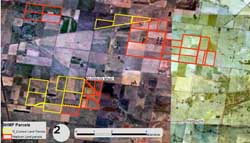 Figure 12. Air photography overlain with land parcels owned by the SHMP pilot farms. |  Figure 13. SHMP land parcels overlain on the airborne gamma radiometric map. |
Farmers involved in the pilot SHMP came into the former DPI Bendigo office for half a day for an interactive session using the GIS running in ArcMap. The corporate data layer for land parcels was used to identify the land owned by the participants. Other layers were viewed to gain a general understanding of the sub catchment landscape, e.g. geology, soils, and airborne gamma.
| Office GIS Session II Using air photo mosaic a draft paddock layer13 was created for each farm. The draft paddock maps were printed and sent to the farmers for checking, numbering and naming. | 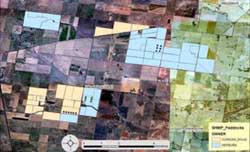 Figure 14. Paddock boundaries within land parcels are delineated from air photographs and used for checking, numbering and naming. |
| Office AgriGater training session Paddock information and farm management scenarios were entered into DPI’s AgriGater program during a training session. (N.B. There is no soil component in AgriGater but this level of planning of the farm business is crucial to building SHMP. | 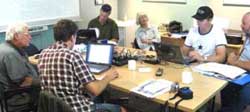 Figure 15. Farmers engaged in training to enter their farm data into AgriGater. |
Paddock walks
Paddock walks on each farm enabled closeup examination of soil and conditions, to discuss the management issues and future actions.
A time was arranged for one to one engagement with each of the pilot farms. Three to five hours was spent with the farmer visiting paddocks that they elected to examine – ten to twelve per farm. This was an opportunity for more considered conversation and interchange of ideas. Hardcopy A4 maps and a clip board were provided to each of the farmers. Four maps were printed:
- Plain map with paddock boundaries.
- Paddock boundaries overlain on air photograph.
- Paddock boundaries overlain on airborne gamma image.
- Catchment scale map of geology overlain with paddock boundaries.
| The maps were used to record information and for general context and discussion about particular features. A penetrometer and soil auger were taken into the paddock and used to (a) determine the achievable depth of penetration, and (b) examine the soil to and beyond that depth. This took time but really forced engagement between farmer and soil to a degree that is never achieved by driving a tractor or just simply looking at surface tilth and conditions. During the walk, the topic of the conversation was broad but included essential information about the use of the paddock, soil condition, pasture quality, this year’s and recent crop, production history, plans, issues, and variability. This was very effective for really getting behind some attitudes, and there were some 'sartori' moments for the farmers. All the paddocks had a reasonably long history of crop and pasture rotations and most showed evidence of compaction. The degree to which compaction is a feature of these soils had not been appreciated previously by the owners. It is easy to talk about compaction in presenting information to groups but there is nothing to beat real observation of soil conditions (e.g. penetrometer resistance, cloddiness, root deformation) to bring the message home. In both pilot cases the farmers had plenty of previous exposure to the ideas, but it was only in visiting the paddocks, on a one to one basis, that the messages really came home. Conversation about practice change and how to achieve it over the medium or long term, rather than all at once, is needed. Without gaining an achievable perspective on time and economics, radical changes can appear to be too difficult. The paddock walks were followed by a debriefing session back at the farmhouse to discuss main findings and how they might affect plans. Some ‘homework’ was left in the form of a table for each paddock with columns to be filled out for:
This is as far as the pilot project progressed within the timeframe and funding. At the annual gathering of the MLSC group both farmers described to the group what they had been doing in the SHMP pilot and spoke very positively about. On the day following this gathering, there was a full day of presentations for group members. Presentations were given on soil water, soil biology and soil organic matter. A separate evaluation report of that day has been prepared by DPI. Three months after this an evaluation was carried out over the telephone with the farmers in the two pilot farms. This is reported in the following section. |  Figure 16. During the farm walk, the auger and penetrometer were given to the farmer to use. |
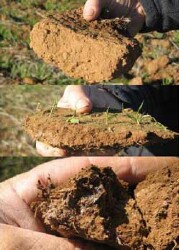 Figure 17. Three examples of differences in soil condition that were observed during the paddock walks: (top) dense and cloddy; (centre) surface sealing and compaction; (bottom) beneficial fungi (white) in soil pore space. |
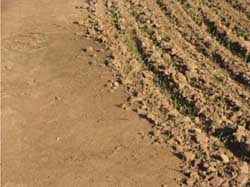 Figure 18. An example of how sealed and hard-set the soil surface has become, and hence the need, in this case, for tillage. | 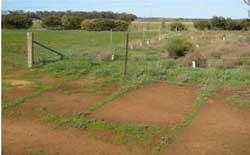 Figure 19. Old rip lines created during establishment of shelter belt show advantages to grass growth in an area of compacted soil. | 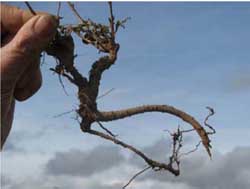 Figure 20. There is nothing quite like a lucerne root to tell you what a plant might be experiencing below the surface. |
Evaluation and future work
The SHMP pilot has been successful in engendering an enthusiasm for understanding and managing soil. It has resulted in change in attitude and brought forward some planning and management that was not previously as a high a priority as it is now. Follow through is still needed with the pilots and there is opportunity to adopt the approach with more members of the MLSC group. DPI's Farmplan21 project could provide the extension vehicle to reach large numbers of Victorian farmers. However providers with appropriate knowledge and expertise will need to be found in DPI and externally.
Evaluation
The leader of the Mid Loddon Sub Catchment Management Group projects, Judy Crocker is engaged in diverse activities with this group ranging from mapping and managing native vegetation to introducing new technology for soil management. When asked about the SHMP pilot, Judy had this to say:
"A farm soil health inventory has the potential to greatly increase the success rate of revegetation projects. The detailed soil structure and farm landscape knowledge gained from an individual farm SHMP has already shown to provide valuable farm surface and sub-soil information to enable more precise planning of direct seeding paddock positioning, methods of ground preparation and seasonal timing." (J.Crocker MLSC group facilitator)
The two principal participants in the SHMP were interviewed on the telephone by a DPI Farm Services Victoria officer, three months after completion of the pilot. The officer asked five questions and the responses are summarised here.
Has the experience been useful?
HH: “Yes It is part of the overall plan.” "it is a bit big to do all at once - each paddock will be taken on its merit" HH found it “really exceptional spending the whole day with RM”. Part of the day was "learning Richard" that is “getting to know the person as well as the information”.
DC: "Quite Beneficial" Taken on a lot of what RM said. Now doing EM38 looking at carbon levels in soils and chook manure "Working on the soil we have got"
Will you be changing any practices as a result? (i.e. what have you learned that you want to incorporate into farm management SHMP)
HH: “No doubt it will be part of the changes depending on the finances and the other parts of the business. Yes more gypsum and to less of an extent lime and chook manure.”
HH also plans to increase the areas treated so there will be fewer small (treated) areas as he understands what they should be doing and where they will have an affect. DC: "Reformation of what we were doing" “Direct drill.” “It will come down to there being a long term financial benefit for things to be applied.”
Do you require more help and, if so, what is the most important thing for you to have further help with
HH: “Not sure at the moment. Not sure until we use it more to found out what the issues or obstacles are.” "He is entertaining"
“Need to do more with AgriGater.”
DC: After the EM38 has been done would like some help interpreting the maps and advice on management or clarification on what it shows up.
Would you have made any of the proposed changes (if there are any) without the SHMP engagement.
HH: “Not in the same detail as we do now having done the work.” “We look more in depth now.” (Looking below the surface to 60 cm or more) HH thought the soil auger and the penetrometer were good. “Have had a soil corer out (on the farm)…we looked at the cores and could see and understand the clay layers and the sodic areas.”
DC: "fast tracked the direction we were going already". "The workshop on organic matter and soil biology was a light bulb moment."
How much of this do you think could be done in a group and how much is needed as personal attention to you and your farm?
HH: “Paddock stuff needs to be one on one with no distractions.” “Group discussions help share the understanding.”
DC: “Should be half and half - good day with RM.” "Nothing brings it home more than walking your property." (This was referring to being able to see where soils are in the landscape e.g. old water courses and other features.) “Information (delivered) at workshops after (a) one on one paddock walk as you can (then) relate it to your own property.” “The hand auger and the penetrometer (are) useful when you have an experienced operator or person with you.” “Getting to know RM not just as an ivory tower person.” “Richard seems to be trying to take what he knows and help put it into some thing that can be applied to farms.”
Future work
The SHMP pilot needs to be followed through with the two initial participants. A taste has been given and the response is positive and enthusiastic. In particular the paddock walks were effective in getting the landholders themselves to see that there are real physical constraints that could be resolved through some management changes.
A system of record keeping has not been introduced or imposed during the pilot, but the participants do need a system if there is to be long term value and monitoring of the SHMP. They should now be in a position to recognise this and be receptive to adopting a system - but it will need to be simple and effective. It will be very valuable if the participants can augment their existing farm business accounts with more detailed documentation of fuel use, tractor hours and area covered. The latter will help to refine inputs into the AgriGater package but should, over time also show whether changes in soil management are reducing the mechanical costs of crop production.
Key issues to follow through with are:
- Record keeping - paddock by paddock and crop by crop record of inputs including tractor hours and fuel
- Plan for monitoring and soil testing.
- Machinery audit and possible long term plan for unifying wheel spacing to support controlled traffic (e.g. 3 metre spacing).
Both the pilot SHMPs were on mixed cropping and sheep farms. One important improvement to soil condition is management of soil structure and dealing with compaction. There is an increasing body of evidence to support the benefits of zero till and controlled traffic systems. The success of these systems has been on cropped land without livestock. A major challenge to an SHMP then is how to design a system that can adopt the principles and practice of zero till and controlled traffic but to include sheep in the system.


